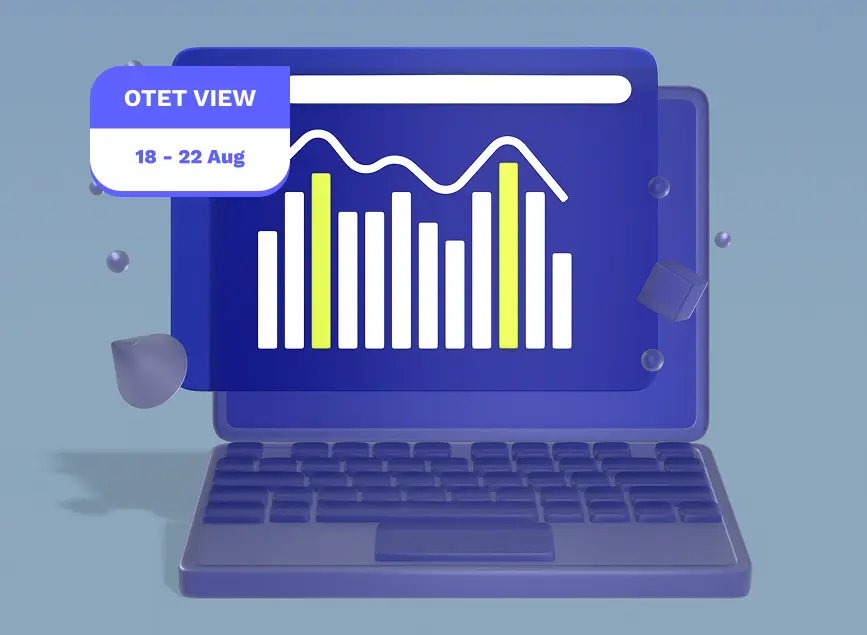
Investors looking for more signs in the week ahead, save the profit of holding the positions?
Global Economic Review
Global growth remains positive but slower as inflation moderates and central banks inch toward cautious normalization, leaving markets to swing with each data print’s impact on rate expectations, the dollar, and real yields. The IMF still projects 3.2% global expansion this year, with advanced economies benefiting from cooling inflation and greater policy flexibility, while many emerging markets struggle with currency volatility and heavier debt burdens. Assets echoed the macro mix: gold softened after a hotter U.S. PPI and a firmer dollar, WTI hovered in the low $60s amid inventory builds and softer risk appetite, and Bitcoin briefly topped $120K before retracing, though ETF-fueled institutional demand remains a tailwind. Inflation releases hint at tariff-related cost pressure, while July retail sales confirm consumers are still spending; the unknowns are how much firms will pass through and how much households can absorb. Abroad, the RBA cut rates, Norges Bank held, and Q2 GDP beat in the U.K. and Japan; China added stimulus as its recovery stays fragile. The Eurozone showed resilience but mixed data: industrial production −0.4% m/m, Q2 GDP +0.1% q/q, HICP ~2.2%. Geopolitically, the Trump–Putin summit yielded no Ukraine breakthrough.
Next week: U.S. Housing Starts, Existing Home Sales; PBoC, RBNZ, Riksbank; Eurozone PMIs.
United States Economic Review
The U.S. economy continued to expand in previous week, with consumer demand resilient and the broader disinflation trend intact. Prices are edging higher at the margin, corporate margins are tighter, and firms appear poised to pass through costs selectively. Together, July’s CPI and PPI reinforced the story of uneven disinflation and preserved Federal Reserve optionality amid uncertainty around tariffs, pricing power, and household tolerance for further price increases.
Inflation details were mixed. Headline CPI rose 0.2% m/m in July and core CPI 0.3% m/m, lifting core’s 12-month pace to its highest since February. Price pressure was broad-based—core goods +0.2% and core services +0.4%—while headline CPI held at 2.7% y/y, effectively range-bound between 2.3%–3.0% for more than a year, consistent with firms absorbing a meaningful share of tariff-related costs to date. Within the basket, energy −1.1% m/m and shelter +0.2% m/m; core was 0.3% m/m, 3.1% y/y, reflecting sticky services, notably medical care and airfares. The bigger surprise came from producer prices: PPI +0.9% m/m (3.3% y/y), the strongest 12-month gain since February, powered by services margins and a 0.7% rise in goods. Core PPI ex-food/energy/trade +0.6% m/m, and trade services +2.0%, signaled growing resistance to margin squeeze and a higher risk of incremental pass-through—likely gradual given tariff volatility and still-cautious demand.
Consumption started Q3 on firmer footing. Retail sales +0.5% m/m in July, with June revised to +0.9%; the control group +0.5% m/m. A pop in autos and higher goods prices boosted the nominal headline more than volumes, while promotion-heavy events and some pre-tariff buying provided tactical lift. Even so, softer discretionary trends in H1, a moderating labor market, and still-elevated prices keep risks skewed toward a cooler H2 as companies take a “test-the-waters” approach to price hikes.
On the supply side, manufacturing output was flat in July. The Fed’s G.17 showed industrial production −0.1% m/m as mining and utilities dipped and manufacturing stalled (0.0% m/m); capacity utilization edged down to 77.5%, signaling residual slack. Sentiment softened: the University of Michigan preliminary August index fell to 58.6 (from 61.7), with 1-year inflation expectations 4.9% and 5-year 3.9%. Initial jobless claims ~224k remain consistent with a still-tight labor market, and the Atlanta Fed’s GDPNow held at 2.5% SAAR for Q3.
Markets responded with modest de-risking. Hopes for a jumbo September cut faded after the PPI, while odds remain elevated for a standard 25 bp move. The dollar firmed into the CPI/PPI and retail releases, then partially retraced after the sentiment data—capturing the tug-of-war between growth resilience and inflation risk.
United States — Weekly Outlook
With July CPI, PPI, and retail sales now in the rearview, investors will focus on four pillars this week: housing health, the business pulse, labor frictions, and policy signaling. The housing data—starts/permits and existing home sales—are especially important for gauging whether higher mortgage rates and strained affordability are containing shelter inflation, the most consequential core-services driver of disinflation. A modest rebound in permits alongside flat-to-softer starts would fit the “gradual disinflation” narrative and temper upside risk to shelter CPI into the autumn (CPI shelter rose 0.2% m/m in July).
Housing. July housing starts are expected to decline about 1.6% as single-family construction remains weak and some of June’s 30% surge in multifamily activity unwinds after total groundbreaking rose 4.6% in June. Single-family permits fell 10.9% from March to June amid soft demand and elevated new-home supply, while multifamily remains supported by firm rental demand in a stretched-affordability backdrop. The NAHB survey shows 38% of single-family builders cut prices in July, underscoring demand headwinds. Looking ahead, multifamily should stay comparatively firm, and a modest mortgage-rate reprieve could gradually aid single-family building. On the resale side, existing home sales fell 2.7% m/m in June to 3.93M SAAR—a 10-month low—with added supply cooling appreciation and some markets (Tampa, Austin, San Francisco) posting outright price declines. For July, sales are expected to slip another 0.5% to 3.91M SAAR; the early-August rate dip may entice buyers later but won’t affect this print.
Business activity. Flash S&P Global PMIs (manufacturing, services, composite) will offer a timely read on demand, pricing power, and hiring. After industrial production slipped 0.1% m/m in July, weaker new orders or faster input-price growth would echo PPI’s message that supply-side pressures are firming even as headline inflation cools. Conversely, firm output and softer price indices would support a “clean handoff” in which the Fed can cut without reigniting inflation.
Labor. Thursday’s jobless claims remain a key gauge. Initial claims in the low-220Ks are consistent with a still-tight jobs market; another benign reading would underpin spending momentum highlighted by July’s 0.5% retail sales gain, even if sentiment remains subdued. A rise in continuing claims—potentially foreshadowing slower wage-income growth into Q4—would be interpreted as dovish.
Policy signaling. Fed communication will be front and center. Markets currently price a high probability of a 25 bp cut at the September meeting, with diminished odds of 50 bp after the hot PPI. Emphasis on “risk management”—balancing disinflation progress with growth risks—would likely cap front-end yields and support duration; a pivot toward “patience” could firm yield and the dollar into month-end.
Wall Street expectations
Equities enter with cautious optimism, and the S&P 500 is likely to trade in a relatively narrow range with a slight downside bias. Tech/AI leaders are vulnerable to profit-taking if guidance skews hawkish. Nasdaq technical flag pullback risk: confirmation would come on a sustained break below the 50% Fibonacci area near 20,000, with support at 22,250, 22,000 (pivot), and 21,000.
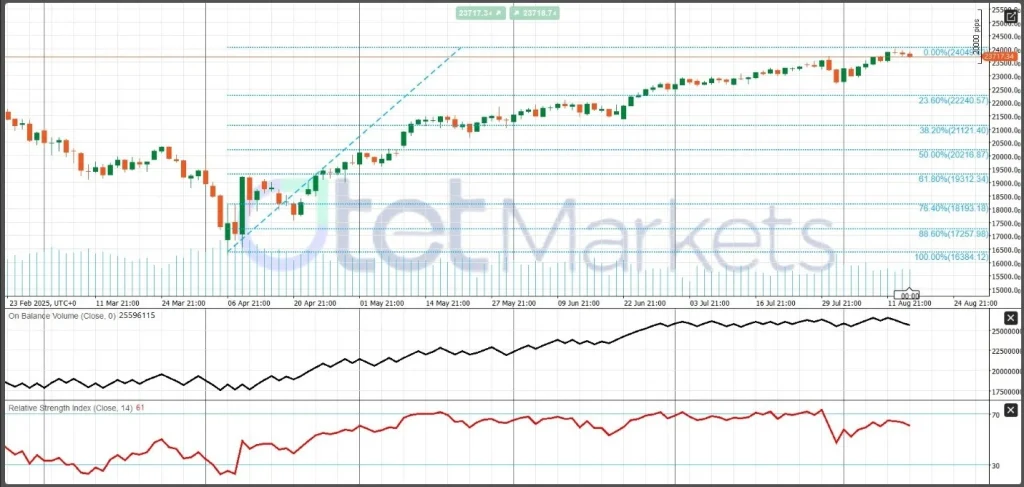
USD scenarios
The DXY’s path hinges on PMIs and housing: firmer growth tilts USD higher; a growth scare softens it. Baseline risks skew mildly lower toward support near 97 if housing confirms disinflation and markets price more aggressive easing, though safe-haven flows can limit downside. Technically, RSI around 46 is neutral-soft; a sustained move above 98 targets 99 and then 101. Volatility (VIX) likely holds near 15–16 but may spike on data or geopolitics, with thin late-summer liquidity amplifying surprises.

Euro Area Economic Review & Expectations
The Eurozone continues to tread water. June industrial production fell 0.4% m/m (-1.1% y/y), with weakness broad-based across consumer goods and energy-intensive sectors. Q2 GDP grew a tepid 0.1% q/q, highlighting how net-trade and capex headwinds offset modest services strength. July HICP headline inflation was ~2.2% y/y—close to target—while underlying measures remain somewhat firmer, keeping the ECB biased toward gradualism.
Germany’s sentiment lost its faint silver lining: the ZEW Economic Sentiment index dropped to 34.7 from 52.7 in July—its first decline in four months and below the 39.5 consensus. France and Italy remain mixed, with services stabilizing but manufacturing constrained by higher input costs and soft external demand.
In the week ahead, flash PMIs will be pivotal for gauging whether manufacturing contraction is bottoming and whether services demand can offset goods softness. These releases are the first meaningful read since the late-July EU–US trade deal, under which the U.S. will levy a 15% tariff on most EU imports—including autos and parts—higher than prior rates but lower than feared, so investors will watch closely to see if confidence holds. Consensus points to a brief pause in the recent sentiment upturn: Manufacturing PMI ~49.5 (still contractionary), Services ~50.8, Composite ~50.6—levels historically consistent with subdued but positive growth rather than recession. Beyond the headlines, watch new orders and export orders (tariff sensitivity), input costs and output prices (pass-through of trade and energy costs), and employment (signals for wage momentum). From a policy perspective, with Q2 GDP and employment modestly higher and wage growth expected to cool alongside easing underlying inflation, in-line or softer PMIs would keep the door open for ECB easing in September. However, there is upside risk that early post-deal sentiment proves more resilient—especially if auto supply chains stabilize and services demand holds—in which case firmer PMIs could push the timing of a final 25 bp cut to December. Country dispersion will be key: auto-exposed Germany is most sensitive to tariffs, while services-led economies could cushion the composite if domestic demand remains sticky.
FX & Rates Implications. EUR/USD remains a function of relative macro momentum and policy-path convexity. Into the week, a balanced PMI outcome likely caps EUR rallies below prior resistance if U.S. data hold and Fed odds stay skewed toward a standard 25 bp cut. A downside PMI surprise would likely pull Bund yields lower and widen rate differentials, weighing on the euro; a positive surprise would narrow spreads.
Technical Picture (EUR/USD). Despite easing after touching multi-month highs above 1.18, technical indicators remain constructive. Initial resistance sits near 1.1820. On the downside, a USD rebound could pressure the pair; a sustained break below 1.1570 would signal a directional shift.
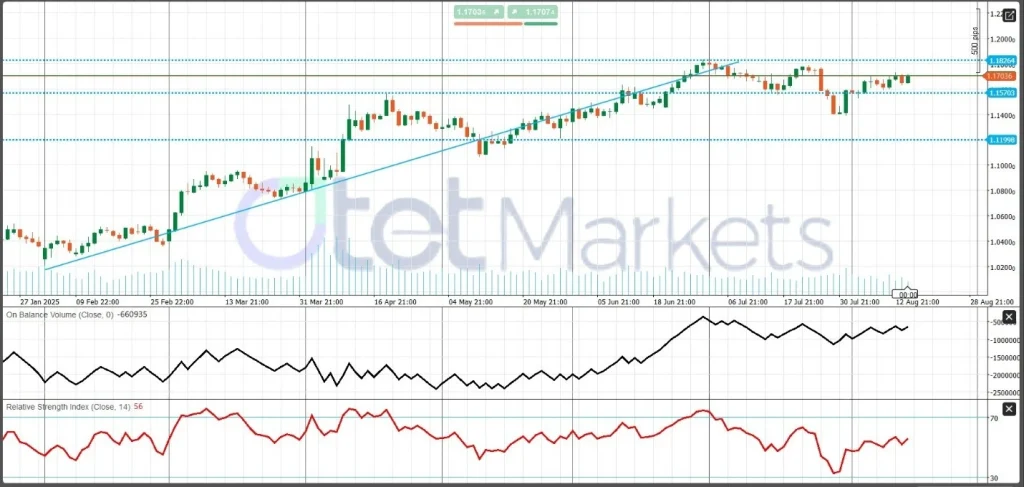
Gold — Market Review & Outlook
Gold cooled last week as the PPI surprise and firm retail sales pushed real yields higher and trimmed bets on an outsized September Fed cut. Spot was on track for a ~1.5% weekly decline, hovering near $3,335/oz into Friday’s close. The dollar’s mid-week strength added pressure before easing after the University of Michigan survey. The metal’s secular appeal as a hedge against policy and geopolitical risk remains intact, but the near-term path is tied to U.S. growth momentum and the Fed’s cadence into September.
On inflation, July CPI’s steady 2.7% y/y and softer energy components were gold-friendly, but the 0.9% m/m (3.3% y/y) PPI reintroduced cost-push risk. The Fed’s reaction function is critical: consensus still looks for two cuts this year, but the balance has shifted toward a standard 25 bps move in September, moderating the “policy put” that buoyed bullion in early August.
On the data front, U.S. housing and flash PMIs will steer real yields and the dollar. Softer prints would likely lower real rates and support gold; upside-surprises would do the opposite. Fed speakers are also pivotal: emphasis on “risk management” and progress on disinflation would aid bullion, while pushback against a rapid easing path would cap rallies.
Base case: with mixed U.S. data, gold likely consolidates in a broad range as markets stick with a standard September cut. If PMIs miss and jobless claims rise, real yields could fall, the dollar soften, and gold may retest recent highs with $3,400+ in view. Conversely, hot PMIs and firm housing would dim prospects for sequential cuts, lift yields and the USD, and pressure gold.
Keep an eye on the DXY and 10-year TIPS yield—they explain much of gold’s week-to-week variance. A firmer EUR on stronger Eurozone PMIs would also help bullion by pressuring the dollar.
Technical picture: XAUUSD remains range-bound between $3,300 and $3,400. Sideways trade is the base case unless price breaks decisively above or below those bands.
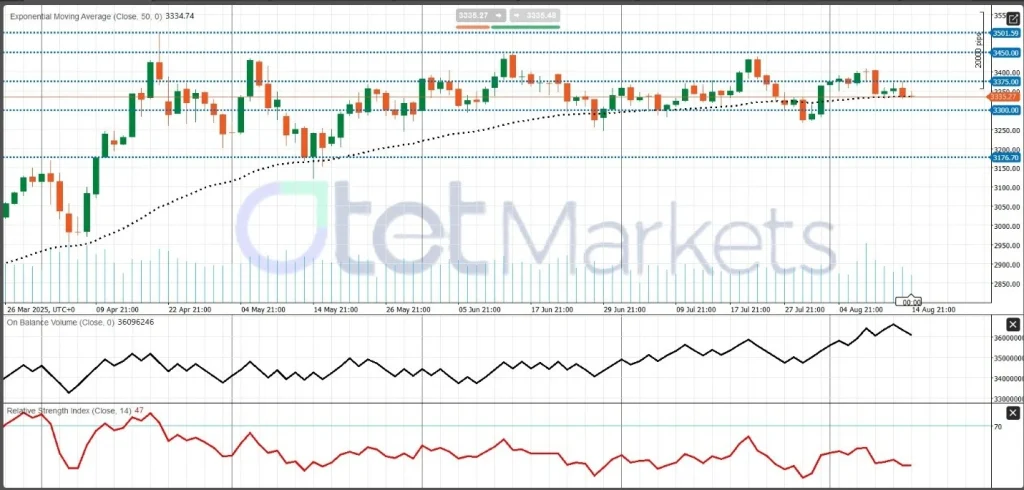
Crude Oil — Market Review & Outlook
Overview. Crude struggled last week. Front-month WTI hovered in the low $60s as macro headwinds—a firmer dollar after the PPI surprise and renewed growth jitters—combined with a U.S. inventory build to offset some of the support from OPEC+ supply discipline. Spot WTI ended the week around $62.
Inventories & runs. The EIA reported U.S. crude inventories +3.036 mb for the week ending Aug 9, defying an expected -0.9 mb draw and reversing the prior week’s -3.029 mb decline; total commercial petroleum inventories rose 7.5 mb. Cushing stocks edged up +0.045 mb. Refinery crude runs increased +56 kb/d, but utilization fell 0.5 percentage points, hinting at seasonal maintenance or outages. Crude imports climbed +699 kb/d. On products, gasoline inventories -0.792 mb versus an expected -1.0 mb draw, while gasoline production was broadly flat (+10 kb/d).
Rigs & supply stance. Baker Hughes showed the U.S. oil rig count +1 to 412; the total rig count was 539, essentially steady w/w. The incremental oil-directed increase suggests producers are cautiously responding to supportive prices and stable well economics, while gas activity remains subdued amid ample inventories and softer benchmarks. Overall, the upstream posture is measured—sustaining output without broad expansion—as shale operators prioritize efficiency and shareholder returns.
Drivers. Risk sentiment and the dollar steered week-to-week price action: PPI-driven USD and yield strength pressured the energy complex before partial relief followed weaker consumer-sentiment data.
Week ahead. U.S. PMIs and housing will shape the demand outlook: stronger prints would support crack spreads and mobility proxies, while misses could revive demand-destruction worries. Weekly EIA/API reports should be watched closely—another build, especially in gasoline/distillates, would cap rallies; draws would signal late-summer demand resilience.
Scenarios. Product draws plus better PMIs and a softer USD → WTI pushes toward the high $60s as steadier refinery runs bolster demand. Another crude/product build plus a stronger dollar → WTI retests recent lows with curve flattening and heavier pressure on prices.
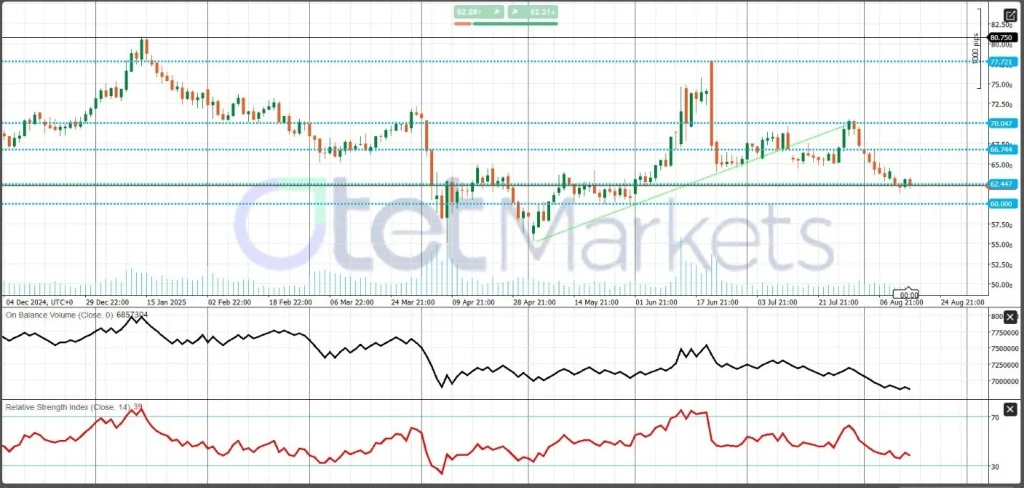
Technical picture. Bias remains bearish with RSI < 40 and waning buying interest, pointing to ongoing downside risk. That said, WTI has carved out support near $60; while that level holds, a recovery back above $62 remains plausible.
Bitcoin — Market Review & Outlook
Bitcoin extended its leadership among risk assets, briefly setting new all-time highs above $120K before pulling back on the hotter PPI print and a firmer dollar. The advance remains underpinned by robust spot-ETF demand and a friendlier U.S. policy backdrop; even after the late-week retracement, BTC is still sharply higher year-to-date. ETF flow and volume metrics continue to support the bull case: BTC and ETH products saw strong summer activity, with periods when ETH inflows outpaced BTC without meaningfully denting Bitcoin’s dominance. Ongoing institutional adoption—larger funds and some treasury allocations—has improved liquidity and damped event-driven volatility.
Crypto has also become more sensitive to macro data. The same PPI surprise that weighed on gold and tech cooled BTC as markets trimmed odds of a jumbo September cut; by contrast, softer sentiment data and steady GDP tracking helped cushion the pullback. Into next week, PMIs, housing prints, and the USD/real-yield trajectory are likely to drive price action; a softer dollar and lower real yields typically correlate with BTC strength.
Near-term watchlist: net ETF flows (IBIT and peers), stablecoin supply growth, funding rates, and futures basis. Also monitor regulatory headlines—policy continuity that preserves institutional access remains a key pillar of the cycle.
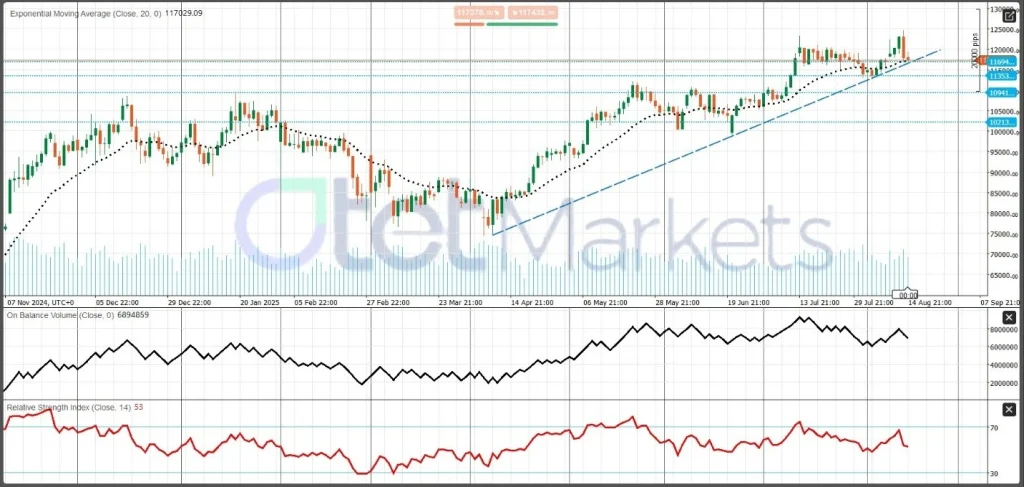
Technical picture: Daily indicators remain constructive. Initial support sits near $113,500, with a key pivot around $109,000. A sustained hold above support keeps the broader uptrend intact.
Share
Hot topics

Will 2026 Be a Turning Point for Crypto Regulation in the U.S.?
The cryptocurrency world is gearing up for a transformative year as a pro-crypto administration, led by Donald Trump, prepares to take charge in the United States. With a Congress expected...
Read more




Submit comment
Your email address will not be published. Required fields are marked *